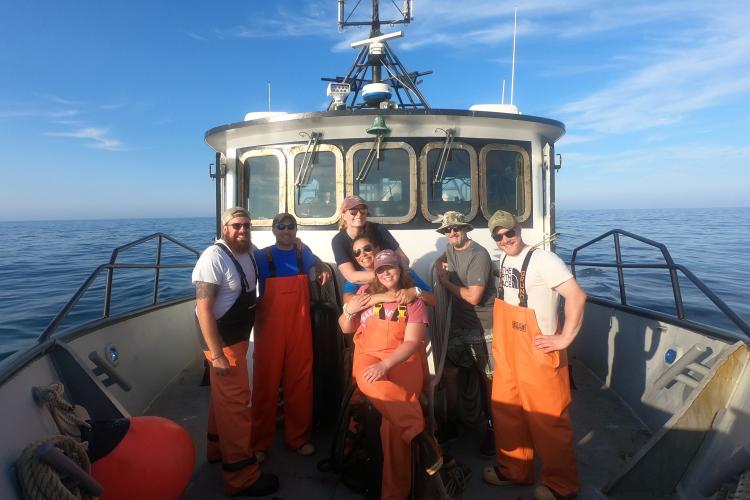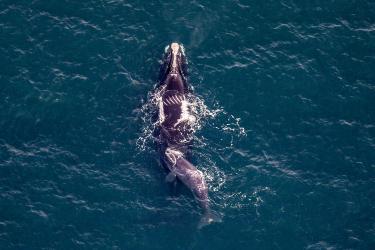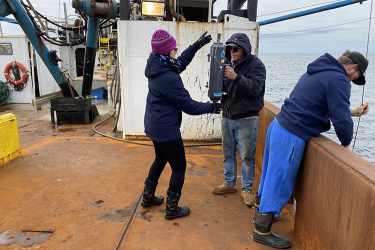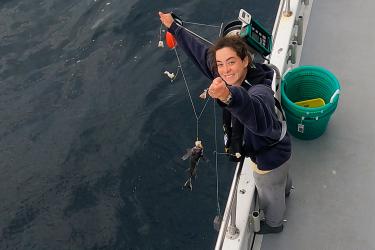Although I’ve been with the Ecosystems Surveys Branch for 3 years now, this was my first time participating in the Atlantic Northern Shrimp Survey. I knew I was going to be trained as a watch chief—the person who oversees the scientific team and data collection—on the second part of the survey, or leg. Then I would sail as a watch chief on the third leg. That’s about all I knew. That and I had heard that the tows were once abundant with Atlantic northern shrimp, but had diminished over the years. I was grateful for the chance to see it for myself this summer.
I met up with biological technicians Sabrina Dahl and Megan Barry to drive from Woods Hole, Massachusetts, to New Castle, New Hampshire, to meet the R/V Gloria Michelle. I packed my sea bag as if I were going to be gone for 2 weeks. That’s about as long as it should take if everything went as planned. Once we arrived, we got settled and made final preparations. We spent the night on the Gloria Michelle so we could throw lines bright and early at 5 a.m. to begin sailing 6 hours to our first station.
This survey takes place in the Gulf of Maine. Over the 5 days of this leg, we completed 23 of the 62 planned stations. For each station, we:
- Set and fish a modified shrimp net for 15 minutes
- Haul the net back to the vessel
- Dump all the contents of the net on an elevated sorting table
- Sort the catch by species, and some by sex, into individual containers for further processing.
- Scan the samples into our integrated fisheries scientific computer system (that’s my job now, as watch chief!)
- Weigh the containers
- Pass the containers to the other scientists to “work up”
To “work up” a container means taking lengths, determining sexual maturity, and taking otoliths. Otoliths are ear bones in fish that have growth rings, like trees, that scientists use to age fish. The catch is then returned back to the ocean.
On this leg, we caught a wide range of species including Atlantic spiny dogfish, Atlantic halibut, and Acadian redfish. We only had a few small buckets full of Atlantic northern shrimp—the species we were after in the first place!
The Atlantic northern shrimp commercial fishery has been closed since 2014 when the stock hit record low numbers. The population has not rebounded. In 2021, one of our research fishery biologists, Anne Richards, published a paper about this decline. She cited warming ocean temperatures and longfin squid predation as major contributors to the stock collapse. Today, an increase in other Atlantic northern shrimp predators—Atlantic spiny dogfish, Acadian redfish, and silver hake—may also be contributing to the decline. Ocean temperatures in the Gulf of Maine remain high.
Once we finished our planned stations, we headed back to port to swap scientific crews. We set sail 2 days later at 5 a.m. to begin the third and last leg. I again sailed as a watch chief, overseeing other scientists and loading all of the species we catch into our integrated computing system.
We were extremely efficient on the first two legs, so this only left a dozen stations for us to do on the third leg. Unfortunately, we didn’t catch a single northern shrimp. This meant we were able to complete all stations planned for the third leg in just 4 days.
On the steam back to port, we saw ocean sunfish, basking sharks, countless sea birds, a breaching sperm whale… well 95 percent positive it was a sperm whale… and one gorgeous scallop-shaped sunset. Although our survey netted a surprisingly low number of Atlantic northern shrimp, the team worked well together. It was a fantastic learning experience and this will absolutely be a survey to remember!
If you’d like to see more of the sights and scenes from this survey, check out my photo gallery.








